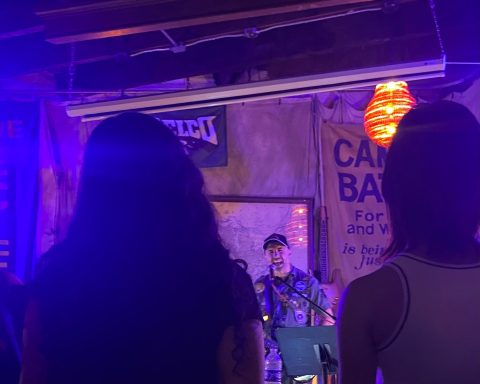Editor’s note: This article was initially published in The Daily Gazette, Swarthmore’s online, daily newspaper founded in Fall 1996. As of Fall 2018, the DG has merged with The Phoenix. See the about page to read more about the DG.
In this installment of the biweekly series “Anxiety at Swat,” David Ramirez, director of Counseling and Psychological Services (CAPS) offered his thoughts on sources of stress coping strategies.
Even before coming to Swarthmore from Haverford in 1994, Ramirez knew of the College’s reputation for being a stressful environment.
“I guess the word on the street then was, no matter how hard Haverford is, Swarthmore is harder,” Ramirez said.
As to why Swarthmore has this distinct reputation in relation to other equally competitive colleges, Ramirez attributed it to the Swattie mindset of social responsibility – responsibility not only to the campus community but also the global community.
To Ramirez, adopting this high level of social activism in addition to a challenging course load can prove to be anxiety-inducing.
“If you were only a student and doing nothing but going to class, that’s a whole life right there!” Ramirez said.
Although Swarthmore makes a wide range of grants and other funding opportunities available to students, Ramirez recognizes that Swatties gradually learn that they can do anything but not everything.
“I think there’s a learning curve for students in terms of their own limits,” he said, “and I think […] that encounter with one’s limits is the hallmark of the challenge to Swarthmore students.”
Regardless of their individual limits, Ramirez has observed that students most often establish standards for themselves based on observations of their peers.
“What I’ll hear very often from students is that they’ll compare themselves to other students” Ramirez said.
When students assess their peers’ activities and accomplishments in comparison to their own, there is a sense of “Why can’t I also do the same?” For instance, a student might admire another for taking challenging courses and engaging in many extracurriculars, without being aware of any difficulty or distress that accompany that perceived success.
As for the particular challenges faced by the current generation of college students, Ramirez attributed them largely to the huge technological revolutions that have taken place in the past decade.
“I think you cannot underestimate the power of [online media] that exists now, the power to know things,” Ramirez said. “And so for people like Swarthmore students who feed on information and enjoy the life of the mind and thinking about everything, it’s like a tsunami.”
In today’s plugged-in society, there is more pressure to be informed about a wider range of subjects, because that information is so readily accessible.
In terms of little things every Swattie can do to cope with stress – a word which is used here to indicate a spectrum of psychological distress, up to and including clinical mood disorders – Ramirez stressed living in the present.
“Everybody, several times a day, can stop what they’re doing and look around and be amazed at life […] and try to tune into whatever it is that calms them,” he said.
Ramirez also emphasized positive thinking about the future and challenging “negative expectations.”
“For anxiety to exist, there must be a future,” he said. “Most anxiety is future oriented, like ‘How am I going to pass that test? How am I going to talk to that person?’
Ramirez referred to these thoughts as “catastrophic thinking.” However, he pointed out the future is inherently unknowable, offering a saying he has used with his children: “Let your imagination be your friend. If you’re imagining something and it’s really negative, you can imagine something different […]. Don’t use it to scare yourself.”
When asked for his thoughts on the quality of conversations on campus about mental health, Ramirez remarked that the acceptance of the reality of mental health problems has increased over the course of his career, as well as the College’s ability to effectively address those problems.
“I think it’s because there’s been progress made towards de-stigmatizing mental health problems,” he said.
In the past decade, CAPS has seen a dramatic increase of students who use their services, as well as an increase in CAPS staff and facilities. There are also a wider range of counseling resources on campus, like the student-run group Speak 2 Swatties and newly-established groups including Coping with Anxiety and Stress by Learning Mindfulness Meditation (CALMM), a grief group, and a group for first-generation college students.
Of course, establishing a safe space for students to speak openly about mental health is an ongoing project.
“[Swat] is not [a] static community,” Ramirez said. “There are always new people coming in who have to be socialized and welcomed into the community, who have to be taught, ‘Hey, it’s okay to ask for help, it’s a sign of strength and maturity.’ […] Unequivocally, I think things have gotten better, but it’s a work in progress to create the conditions for honest, open expression for emotional distress.”
Featured photo courtesy of swarthmore.edu.
















I wish this series weren’t called “Anxiety at Swat.” As a Swattie with an actual anxiety disorder, I know that it is decidedly NOT the same as being stressed out about schoolwork, which is all this series appears to address.
As a Swattie who also has an “actual” anxiety disorder, I’d like to remind you that anxiety disorders come in many forms and affect people in many different ways. Two people may be living with the same “type” of clinically diagnosed anxiety and have entirely different lived experiences.
I can’t speak for anxious, but I imagine they understand that everyone has a different lived experience so your reminder seems unnecessary and I agree with Anxious that this particular article is more about everyday stress, which is not the same as what many people with serious anxiety disorders are living with. I am sorry that you and Anxious have diagnosed anxiety disorders. I wish you both the best and hope that Professors and fellow students show you and Anxious the understanding and support you need. I am disappointed that this article focuses on stress and I feel that using anxiety in the title diminishes the difficulties my friend at Swarthmore is going through.
Hi Anxious,
Thank you for reading, and for your comment. You are correct that the last two installments of “Anxiety at Swat” have featured faculty and staff members discussing “stress,” a term we use to encompass a spectrum of psychological distress, up to including clinical disorders.
The first two installments of this series, however, featured students with diagnosed anxiety disorders:
http://daily.swarthmore.edu/2013/11/20/anxiety-at-swat-erika-cancio-bello-15-talks-accommodations-and-support/
http://daily.swarthmore.edu/2014/02/04/michelle-myers-15-talks-caps-and-mental-health-discussions/
I think you are right that these terms can be very vague and confusing – “anxiety,” especially, is a term used often in both a clinical and non-clinical sense.
We will try to be more precise in the future with our language, but do know that the use of “anxiety” in the title was intended to encompass both the clinical and sub-clinical areas of the spectrum, much like “stress.” “Anxiety,” however, has more specific connotations of certain physiological, cognitive, and emotional symptoms, which we wanted to draw attention to.
Best,
Abby Holtzman ’16, Co-Editor in Chief of The Daily Gazette